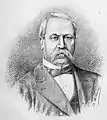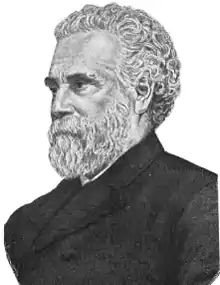Monstrous coalition
"Monstrous coalition" (Romanian: Monstruoasa coaliție) is the name that has remained in the collective consciousness of Romania to refer to the alliance between conservatives and radical liberals in order to obtain Alexandru Ioan Cuza's removal from power in 1866. This name was promoted in its time by press favorable to Cuza.




Background
Although at the first analysis a coalition between the political centrists (radicals) and the political right (conservatives) seems unnatural in the context of 19th century politics of Romania, it was logical within the political context of the time: the personal authoritarian regime introduced by Cuza.
Authoritarian tendencies began to be manifested by the ruler early in 1863, and the personal regime was installed after the coup of 2 May 1864. He increased his own power at the expense of other institutions. On 10 May, Cuza amended, through plebiscite, the Paris Convention which had hitherto functioned as Constitution for the United Principalities, transforming it into Developing Statues of the Paris Convention.[1] The most important change was the redistribution of state organization so that the ruler should have more powers. From this point, the political scene was divided into two camps: Cuzists and opposition. Moreover, the ruler understood to govern over political groups with trustworthy people, of moderate shades, as Mihail Kogălniceanu or Nicolae Crețulescu.[2]
The leaders of this coalition were the radical C. A. Rosetti, conservative Lascăr Catargiu and the moderate Ion Ghica.
Consequences
The "monstrous coalition" was supported by large landowners and businessmen who were not satisfied with the policy of the ruler. Coalition emerged after the National Assembly elections in Romania, second convocation, in 1864, and was chaired by Ion C. Brătianu. Mihail Kogălniceanu remained loyal to Alexandru Ioan Cuza. In 1866, the coalition gave a coup d'etat. On the morning of 11 February, five o'clock, a group of soldiers entered the Royal Palace and forced the ruler to accept the abdication. Cuza was forced to swear that he will abdicate, after seven years of reign, to leave the throne to a foreign prince, as is required in one of the provisions of ad-hoc divans of 1857.[3] The unionist press related that the argument of this heinous act was the charge that the elected ruler would have betrayed the interests of the country to a foreign power.[4]
Two days later, on 13 February, Cuza leaves Bucharest, taking the road of Vienna, and, after him, on 10 May 1866, Prince Karl of Hohenzollern-Sigmaringen is proclaimed ruler of Romania, under the name of Carol I. Subsequently, Carol was asked to allow Cuza return home. The monarch sent the request to the Council of Ministers that rejected it.[5]
References
- Florin Marin, Mihai Voinea (26 January 2011). "Cuza, erou sau dictator?". Historia.ro.
- Smeu, Georgeta, Dicționar de Istoria Românilor, Bucharest, Trei Publishing House, 1997
- Lieutenant Colonel Popescu Lumină, Universul, 17 August 1932
- Tudor Cireș (11 February 2013). "Cuza și "monstruoasa coaliție"". Jurnalul Național. Archived from the original on 3 December 2013. Retrieved 29 November 2013.
- Ion Cristoiu (30 April 2006). "Istoria ca telenovela - O nație fără principii clare". Jurnalul Național. Archived from the original on 3 December 2013. Retrieved 29 November 2013.